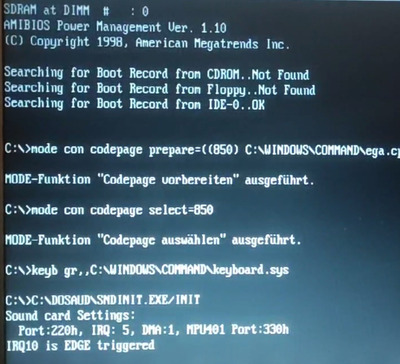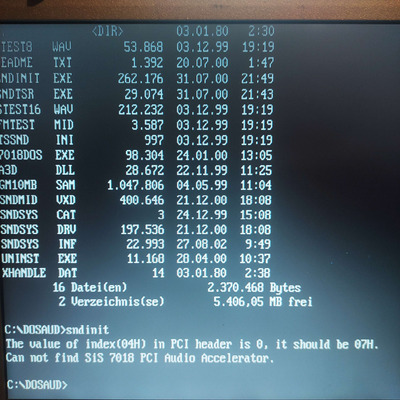First post, by elianda
- Rank
- l33t
Hello,
I recently got a Gericom Webboy Easy Laptop which uses an integrated SiS 630 chipset.
I tested it a bit and writeup here some stuff I found about the sound drivers:
There are still official sound drivers available from the SiS page, dating around 2002.
Also the laptop came with sound driver dating in the readme from 12. Dec. 2000.
Setup.exe without parameter installs for Win98SE, WinME by default the WDM drivers.
However there are command line switches:
-ar Installs Audio Rack
-vxd Installs VXD drivers that include SB16 emulation for DOS window
-lg Installs DOS drivers.
The -lg option did only work with the older laptop driver package. With the latest official the installer shows the selection and sets up autoexec.bat, but no files are copied...
By default in C:\WINDOWS\SYSTEM a soundbank called GM10MB.SAM is copied and used for Wavetable playback in windows.
I could take a GM80MB.SAM (ca. 6 MB size) from the ALi M5451 PCI audio accelerator driver 1.41.0000 and replace the GM10MB.SAM for better samples.
(Somehow both solutions use the identical sound bank format...)
DOS:
There are two programs that are copied to C:\WINDOWS\SYSTEM SNDINIT.EXE and SNDTSR.EXE.
SNDINIT is without command line parameter interactive and sets up TSSND.INI (also in C:\WINDOWS\SYSTEM).
The solution could support SB Pro, SB16, OPL and MIDI, where for me MIDI was always greyed out in the interactive dialog.
SNDINIT.EXE uses /INIT for initialisation the ini can be given with /F so that the call looks like:
C:\WINDOWS\SYSTEM\SNDINIT.EXE /INIT /FC:\WINDOWS\SYSTEM\TSSND.INI
This line initializes the card and loads the soundbank given in the ini file under [Option] as SampleSetFile=
default is 0, I replaced it with GM80MB.SAM copied from the Ali driver to C:\WINDOWS\SYSTEM
So:
[Option]
SampleSetFile=GM80MB.SAM
If you want to hear some test sound on load then set PlaySoundAtInitial=1 in the same section.
SNDINIT sets the BLASTER variable and defaults to SB Pro. However it allows to be changed to SB16 with /I /16 but not in the same call as where /INIT appears.
So I added a second line:
C:\WINDOWS\SYSTEM\SNDINIT.EXE /I /16
to change to SB16 Mode.
(note use /R to unload)
Now this does not enable OPL or MIDI. This requires to load a TSR:
LH C:\WINDOWS\SYSTEM\SNDTSR.EXE
The TSR MUST have GM10MB.SAM in C:\WINDOWS\SYSTEM (even if no windows is installed). Replacing with GM80MB.SAM does not work for DOS as SNDTSR complains with a too large bank file.
This enabled for me SB16 and OPL playback through the Wavetable, though I am not sure if actually the 6 MB or 1 MB is used.
I could not get MIDI by MPU-401 through 330 running, even when setting it manually to enable din the ini file. Maybe the greyed out dialog in the interactive SNDINIT.EXE is an indication that it is not supported at all.
That SNDTSR.EXE requires to have the 1 MB size GM10MB.SAM in C:\WINDOWS\SYSTEM collides with the possibility to replace GM10MB.SAM with the 6 MB file GM80MB.SAM for the Windows VXD driver. So two configurations are needed and the right file has to be copied to C:\WINDOWS\SYSTEM\GM10MB.SAM beforehand.
Finally:
- two separate configs for windows bootup and DOS bootup
- in autoexec.bat to enable SB16 + OPL through Wavetable
C:\WINDOWS\SYSTEM\SNDINIT.EXE /INIT /FC:\WINDOWS\SYSTEM\TSSND.INI
C:\WINDOWS\SYSTEM\SNDINIT.EXE /I /16
LH C:\WINDOWS\SYSTEM\SNDTSR.EXE
- Use older drive rpackage to be able to extract/install DOS drivers
- VXD driver also takes 6 MB wavetable from Ali driver package
Someone has a hint, how MPU-401 might be enabled in DOS or at least emulated from Win98SE?
Latest SiS 630 drivers: ftp://retronn.de/driver/sis/630/
Gericom Webboy Easy drivers: ftp://retronn.de/driver/Gericom/Webboy_Easy/
These contain the older sound drivers for SiS 7018 that allow DOS install as well.
Retronn.de - Vintage Hardware Gallery, Drivers, Guides, Videos. Now with file search
Youtube Channel
FTP Server - Driver Archive and more
DVI2PCIe alignment and 2D image quality measurement tool

